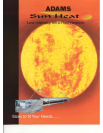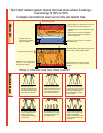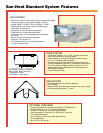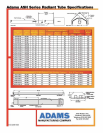
“ Sun-Heat” radiant system directs the heat down where it belongs…
fuel savings of 30% to 50%
Compare conventional warm air to infra-red radiant heat.
Warm Air
Radiant Heat
The balance of the radiant
heat is reflected from the
heating surface to be
absorbed by surrounding
cool surfaces.
A part of the secondary ray
energy, now of longer wave
length, is absorbed by
moisture and particles in the
air, which helps to raise the
temperature.
As a secondary effect, the
room temperature is raised
by convective transfer from
the heated surface.
Infra-red rays travel in
divergent straight lines from
heat source to all surfaces
and objects without heating
the air they pass through.
In addition to those rays
which travel directly from the
heat source, other rays are
re-directed downward by a
mirror surfaced reflector.
90°
70°
60°
75°
65°
70°
No air movement, but
same comfort level, with
lower thermostat setting.
No stacking effect; greatly reduces static pressure
at the roof line, reducing costly infiltration.
With the comfort of warm floors, building
is heated from floor up instead of from
roof down.
Low stack temperature 300°
Reradiation from concrete mass
results in even temperature
throughout the building.
Negative pressure at
the perimeter of building
allows for infiltration.
High temperature or static pressure at the roof
line increases heat transfer through roof.
The higher the bay area, the higher the static
pressure.
Because of air movement in the building
space, thermostat must be set higher to
achieve comfort level.
Cold floors in most cases are 10° less than
thermostat setting.
Listed by CSA for vented or unvented application.
20% to 25% stack loss
120
o
and higher.
Discharged air rises to roof line.
What is infra-red and how does it work?
A portion of the ray’s energy
is absorbed by cooler receiving
surfaces. Conduction carries
some of the heat deeper into
the heated material creating
a heat reservoir.






